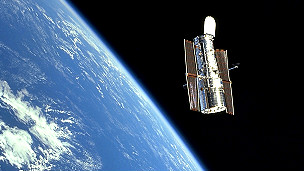Our eyes to the Universe 人类观测宇宙的“眼睛”
Vocabulary: space 太空

Hubble’s orbit is 370 miles above the Earth
收听与下载
The Space Telescope Hubble has changed the way we look at the universe. In its 25 years of activity it has captured over a million images of deep space.
The Hubble drifts 370 miles above the Earth, in a much better position to observe the cosmos than ground-based telescopes. It avoids the distortions of the atmosphere, and takes extremely high-resolution images with very little background light.
NASA Administrator Charlie Bolden says: "Even the most optimistic person to whom you could have spoken back in 1990 couldn't have predicted the degree to which Hubble would rewrite our astrophysics and planetary science textbooks."
Before the telescope was launched, there were doubts about the age of the universe. Some said it was 10 billion years old and others thought 20 billion. Now, thanks to Hubble's observation of stars, we know it's 13.8 billion years old. The telescope has also helped to reveal the accelerating expansion of the universe and provided evidence of the existence of massive black holes at the centre of galaxies.
But this hasn't been an easy journey. Named after the US astronomer Edwin Hubble, it left the Earth's surface on the back of the space shuttle Discovery. But the initial images were fuzzy and crucial repairs were made to its mirror in 1993.
Now Hubble is probing objects up to 50 times fainter than before. Its aim is to reach as far back as possible, when the first stars were forming, just a few hundred million years after the Big Bang.
Hubble has lasted ten years longer than expected. It will be succeeded by the James Webb Space Telescope, which is due for launch in 2018.
Glossary 词汇表 (点击单词收听发音)
- telescope 望远镜
- deep space深空,外层空间
- to drift漂移
- cosmos宇宙
- atmosphere大气
- high-resolution 高分辨率的
- astrophysics 天体物理学
- planetary与行星有关的
- expansion 扩张
- black hole 黑洞
- galaxy 星系
- astronomer天文学家
- space shuttle 航天飞机
- fuzzy 模糊的
- probe (动词)探测
- faint 模糊的,暗淡的
- Big Bang 宇宙大爆炸

